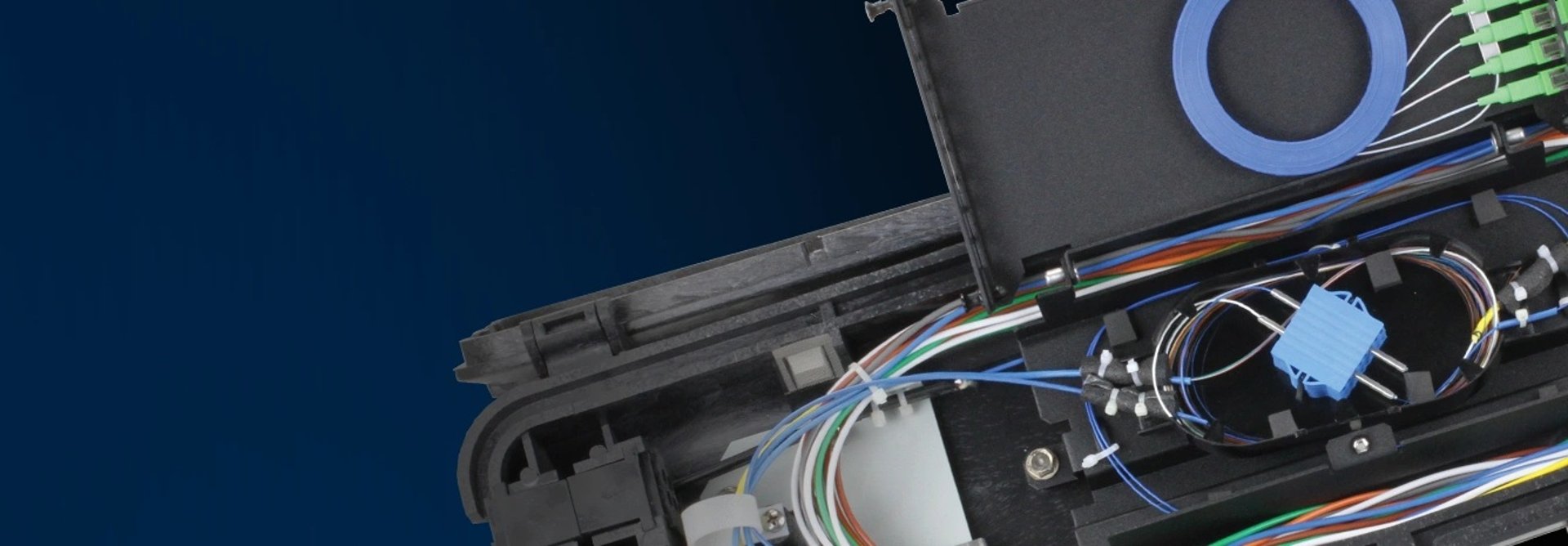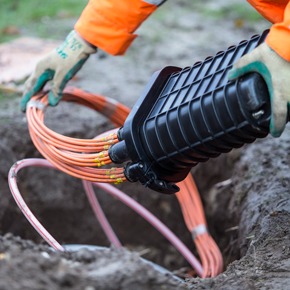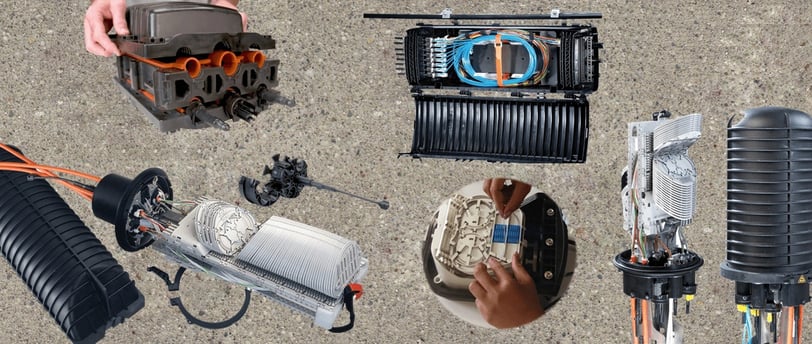
Fiber closures are essential components in fiber network
Closures a secure for the storage and management of fiber optic splices, ensuring the longevity and effectiveness of the network.
10/9/2024


Understanding Fiber Optic Splice Closures
Fiber optic splice closures are essential components within fiber optic networks, designed to provide protection and support to spliced optical fibers. These closures offer a secure environment for the storage and management of fiber optic splices, ensuring the longevity and effectiveness of the network. Typically, a splice closure is housed in a robust enclosure that safeguards against moisture, dirt, and other environmental factors that could compromise the integrity of the fibers.
The primary purpose of a fiber optic splice closure is to seal the splice points where optical fibers are joined, whether through fusion or mechanical splicing methods. Each closure is equipped with a range of features tailored to protect the optical connections contained within. This includes waterproof and dustproof capabilities, which are vital in both indoor and outdoor installations. By keeping splices safe from external elements, these closures play a pivotal role in maintaining the high-speed data transmission that fiber optics are known for.
A typical splice closure consists of several key components. These include the main housing, which houses the splices, protective trays for storing the fibers, and sealing mechanisms that ensure the enclosure remains impervious to outside conditions. Additionally, fiber management systems within the closure help organize and route the fibers efficiently, reducing the risk of damage during maintenance or installation operations. These features not only enhance signal integrity but also simplify the process of accessing and modifying splices without disrupting the network's performance.
In the context of fiber optic networks, the use of splice closures is paramount. They not only facilitate the assembly and maintenance of fiber connections but also ensure that the electrical signals travel with minimal loss, thus supporting the reliability and robustness that modern telecommunications infrastructure demands. Understanding the function and design of fiber optic splice closures is essential for anyone involved in fiber optics deployment and management.
Types of Fiber Optic Splice Closures
Fiber optic splice closures are critical components in maintaining the integrity and performance of fiber optic networks. They serve the essential function of protecting spliced fiber connections from environmental factors, physical damage, and moisture intrusion. There are several types of fiber optic splice closures available in the market, each engineered to meet specific requirements based on installation scenarios and operational environments.
One common type is the inline closure, which is typically used for underground installations. Inline closures are designed to allow multiple fiber optic cables to join together in a linear configuration. This design is particularly advantageous in scenarios where space is limited and a streamlined connection is necessary. Furthermore, inline closures often feature robust sealing mechanisms, ensuring a high level of protection against water ingress.
Dome closures are another popular option, characterized by their dome-shaped design that accommodates a larger number of splices. These are particularly beneficial in environments that may require additional fiber capacity or future expandability. Dome closures allow for easy access to the splice points, facilitating maintenance and repairs while providing excellent environmental protection.
Lastly, rectangular closures are employed in scenarios where space is not a constraint. Designed to provide more extensive internal organization, rectangular closures can house a significant number of fiber splices securely while still allowing for straightforward access. This type of closure is often used in centralized installations, such as data centers, where multiple cables converge.
Understanding the various types of fiber optic splice closures and their unique features is vital for professionals tasked with designing and implementing fiber optic networks. Selecting the appropriate closure ensures optimal performance and reliability, safeguarding the network from potential disruptions and damage.
Installation and Maintenance Best Practices
Proper installation and maintenance of fiber optic splice closures are critical for ensuring the reliability and longevity of fiber optic networks. The installation process should begin with thorough planning and site assessment, taking into account environmental factors such as temperature, humidity, and potential physical hazards. Selecting an appropriate splice closure suited for the specific conditions is fundamental. For instance, closures designed for underground use should offer better moisture protection than those intended for aerial application.
During the installation phase, it is essential to follow the manufacturer’s specifications meticulously. This includes preparing the fiber optic cables correctly, ensuring all components are clean and free from contaminants. It is particularly important to avoid excessive bending of the fibers, as this can lead to increased attenuation and potential signal loss. One common pitfall is neglecting the securing of cables within the splice closure. Improperly secured cables can lead to physical damage or, worse, disconnection over time, compromising network integrity.
Post-installation, ongoing maintenance is equally important. Regular inspections should be conducted to identify any signs of wear or damage. This includes checking for moisture ingress, which can lead to corrosion and fiber degradation. Utilizing visual inspection tools, technicians can quickly assess the condition of the splice closures. Additionally, ensuring that closures remain sealed and free from debris is crucial in maintaining performance. Monitoring environmental conditions around the installations can also help in anticipating potential issues before they escalate. If any anomalies are detected, prompt corrective action must be taken to prevent further damage.
In summary, practicing meticulous installation and maintaining fiber optic splice closures through regular inspections and environmental monitoring are key strategies that will enhance network reliability and performance. Staying vigilant about these processes will help in preventing common issues that may compromise the integrity of the fiber optic network.
Future Trends in Fiber Optic Splice Technology
The evolution of fiber optic splice closures and related technologies reflects the growing demands of modern telecommunications and data transmission needs. As the demand for high-capacity networks escalates, innovations in splice closure technology are becoming paramount. Manufacturers are exploring improved materials that enhance the durability and lifespan of splice closures, offering greater resistance to environmental factors such as moisture and temperature variations. These advancements help ensure the integrity and reliability of the connections within fiber optic networks.
One of the prominent trends in the industry is the development of automated splicing techniques. Automation not only increases the efficiency of the splicing process but also helps in reducing human error, which can impact the overall performance of the network. Automated machines are designed to perform splicing with precision, leading to lower insertion loss and improved overall system performance. This technology is particularly beneficial in large-scale deployments where numerous splices need to be completed in a short timeframe.
In addition to automation, the shift towards environmentally friendly practices is influencing the design and production of fiber optic splice closures. Manufacturers are increasingly utilizing sustainable materials, thereby aligning with global efforts to minimize environmental impacts. This trend not only makes the closures more cost-effective but also appeals to organizations aiming for greener operational practices.
The role of splice closures in facilitating the expansion of fiber optic networks cannot be overstated. As network providers seek to accommodate the ever-increasing data traffic, the reliability provided by advanced splice closures becomes essential. These closures act as secure junctions that protect vital connections from external risks, making them critical in maintaining a high-capacity and resilient infrastructure. Consequently, staying abreast of these future trends is crucial for professionals in the industry, ensuring that they can adapt to the evolving landscape of fiber optic technology.


Your trusted online source for fiber optic products.
© 2025, All rights reserved to Fiber Xpress Mart.
Contact Us


